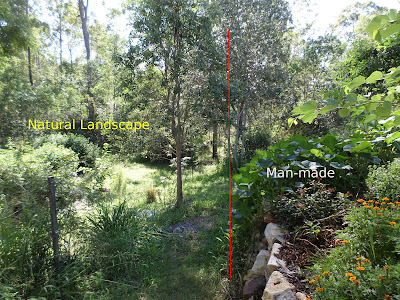They live mostly off natural rainfall, and the lime tree in particular, has had to cope with full sun in every summer growing season.
Lime Tree, planted July 2008
Both trees are planted near block retaining walls, so they drain really well (great for drainage) but they also dry out really quickly too - which is bad for fibrous roots. The lime tree above, recently got a hard prune for the first time in its young life. I wanted my trees to grow in the Jackie French way, where I didn't prune the tree - allowing nature to dictate how it preserved itself. Mainly because I wanted these trees to look after themselves too. I didn't want to mollycoddle them every year, in case I couldn't be there to rescue them every year.
Mysterious lichen
The Jackie French way, certainly made the trees survive the furness which is our summer growing season. Had I chopped back limbs, I'm sure the summer sun would have dried the earth underneath and killed these trees quicker - especially last summer. But the branches grew intertwined and gave the tree a thick canopy above. Enough that it could even grow Lichen on selected branches underneath.
I would not have been able to photograph the Lichen if I hadn't given the tree a sever prune recently. The branch (above) is facing the western sun. Which goes to show, the canopy of the tree grew specifically to protect the trunk from the hottest sun - the afternoon sun from the west. I was fascinated to find the Lichen growing on that side, because it demonstrates the supreme intelligence and adaptability of nature. Hottest sun of the day (no worries) intertwine the branches to prevent exposure.
Lower branches removed
As I was pruning the tree limbs, I noticed something else about nature's intelligence. It grew branches perfectly, to balance the weight in each limb. It took a while, carefully observing, where I should prune each branch to open up the canopy. I had to select branches that wouldn't unbalance the limbs by removing them. After six years growing the right way to protect itself, I didn't want to set it up for failure next summer. So each branch I removed, had to balance out somewhere else.
Which brings me to explaining, why, if I had such success with the Jackie French way of managing trees, I would revert to the Peter Cundall enthusiasm for pruning trees instead? First point is simply the ease of management, but more importantly, only because disease management became an issue. I need to show the fruit to explain further.
Healthy lime fruit
Here is the lime tree fruit, which despite the summer heat, bore heavily. For the most part, they were healthy fruit, but a few started to exhibit signs similar to the lemon tree, that was now in dire straits.
Lemon fruit with citrus scab
I've not had a decent crop of lemons since 2011 and mostly because of the increased shade, due to trees growing-up around it. Also, having too many branches crossing on the lemon tree, has not helped either. It set the conditions to become a pest haven for everything to attack, when it was (once upon a time) our best producer.
Lemon branches
This image is of the lemon tree, but also what I had to deal with, when pruning the lime tree. Intertwining branches aren't so bad at the top of the tree, but when its all over, its difficult to see what's happening until the fruit start exhibiting problems. I would have continued with the Jackie French way of growing trees, had my six year old citrus, not shown a decline in health.
Eureka lemon tree
I should mention, the two trees pretty much managed themselves for five years, so the Jackie French method works. But when intertwining branches become a problem to the overall health of the tree, they should be removed. That should be judged by each tree, every season. Some trees may not need interference at all. My two oranges and one mandarin, have not been pruned, and produce healthy fruit.
Lime tree, right
I'm attempting to improve the moisture prospects for the lime tree also, by using a swale like berm, made from tufts of grass I've removed from elsewhere. The lower image gives a better view of how the berm/swale will collect moisture in rainy periods, because its taken from the top. The lime tree looks very bare at the moment, but I've pruned in Autumn, so foliage will get a chance to grow back before the next summer heatwave.
Lime tree, left
I like to use the big tufts of grass in the garden now, because I see it as a valuable resource. In the past, I would have purchased bales of straw to mulch around my trees instead. But I don't see the point in using energy to acquire materials, which I already having growing around me. It's not a neat, immediate bundle I can purchase conveniently from the store, but it's just as good at doing the same job, once I collect the materials in my garden and mound them together.
I'm happy to have started with the Jackie French approach (my trees are alive because of it) but intervention is sometimes required once problems arise. I don't believe the method is flawed just because I ran into problems six years down the track. Nature is doing exactly what it should be doing - weeding out the trees that aren't vigorous enough to compete with other elements. Having invested so much time waiting for edible trees to produce however, it would be counterproductive, not to find different ways to give them a slight advantage.
Minimal maintenance, has now become a little more involved, but the focus is still for the trees to ultimately look after themselves.
I will continue to allow as many trees as possible, to go without much intervention from me, beyond the first year. But I also know, I don't have to let a mature tree die just because it runs into some trouble either. I prefer the wilderness garden approach, but I can handle some extra work when its justified.



















